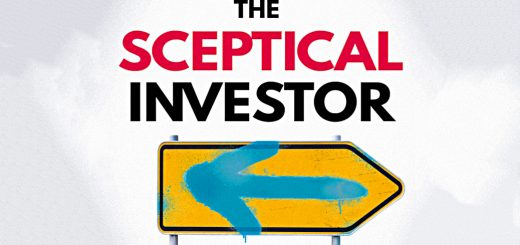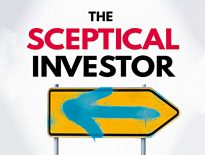The Sceptical Investor 4 – Bubbles, Valuations and Forecasts

Today’s post is our fourth visit to a popular UK investing book from last year – The Sceptical Investor by John Stepek.
Bubbles
The definition of a bubble is a dramatic price increase followed by a collapse.
- So how do you know you are in a bubble before the collapse?
If you did know, you could get out before the top, and make a lot of money.
- But in practice, no one knows which assets will go into a bubble
- And once you are in one, there’s no way to work out when it will burst.
John points out that the Nasdaq almost quadrupled after Alan Greenspan warned of “irrational exuberance” in December 1996.
Mean reversion
Closely related to the concept of bubbles is that of mean reversion.
- When valuations are far away from the intrinsic or fundamental value (usually based on future cash flows), they can be expected to move back towards them, often over a period of years.
Cliff Asness says:
“Bubble” should indicate a price that no reasonable future outcome can justify.
John says that:
GMO view an asset as having entered bubble territory when it is valued at two or more standard deviations away from its long-term trend.
This should only happen once every 44 years.
- GMO has identified 35 moves like this, of which 33 ended up in busts.
John cautions:
While valuation can confirm for you that a market is expensive, it can’t tell you when it has gone over the edge into the unquestioning bullish hysteria that a proper bubble requires. A very expensive asset can carry on getting even more expensive for much longer than you might think.
As David Einhorn said:
Twice a silly price is still just silly.
So sentiment is important.
Bubble stages
John identifies five stages of a bubble:
- Recognition of huge potential
- A transformative new technology or a major demographic, financial or political shift.
- A good story and a smart group of early investors.
- Establishment sneers and sceptical voices.
- Rationalising away the early gains and some buy-in from bigger players.
- Increasingly unstable financing (leverage) as those who missed out play catch up.
This is all true enough, but I’m not sure how much use it is to investors.
John has a few red flags to look out for before the bubble bursts:
- Rising interest rates turn off the cheap money taps.
- A final “melt-up”
- Hyperbolic price acceleration, caused by FOMO.
- Deteriorating fundamentals.
- Reluctant bulls and capitulating bears.
- Big M&A deals and IPOs
- Since it’s the best time to sell an expensive / bubble asset.
- Extraordinary statistics and things that make no sense
- John is thinking here of the claim that in 1989, the land under the Emperor’s Palace in Tokyo was worth the same as all the real estate in the state of California
John also has a few options for how to play a bubble.
- You could sit it out.
- Most bubbles and crashes (with the major exception of 2008) would have been pretty easy to dodge.
- And with microbubbles (lithium, 3D printing, buy-to-let, crypto, cannabis), if you miss this one, another one will be along in a year or two.
- You should resist the temptation to short it.
- Leverage and potentially unlimited losses are the reasons.
- Unless you are Templeton, of course (see the previous article).
- Look for anti-bubble assets that will benefit when the trend changes.
- You could have shifted out of tech in 1999 and bought commodities and property.
- When the market recovered in 2009, tech stocks became hot again.
- Protect your profits.
- If you did get reasonably early, use rebalancing and / or trailing stop losses and / or trend-following strategies (moving averages) to get out at a good price.
Busts
The best thing about bubbles is that they create busts, which are great buying opportunities.
- Which is great so long as you’ve kept some cash on hand to invest.
Things should start to look cheap, and sentiment will be awful.
- At the same time. you should resist the temptation to sell things unrelated to the bubble.
This is the point at which you really need to understand what’s in your portfolio and why it’s there. The falling price is not a good reason to sell what you believe is a good quality asset.
John points out that timing the bust is less crucial.
Bailing out of a bubble market too early can be extraordinarily frustrating.
An undervalued market can fall a lot further and for a lot longer than you might expect. But if you start feeding money in when you think it’s cheap, then in the longer run, you’ll make money.
Valuations
The most popular market valuation measure is the CAPE or cyclically-adjusted price/earnings ratio, also known as the Shiller PE.
- This uses an average of ten years of market earnings compared to the current price.
- The idea is to filter out the business cycle (which is usually shorter than 10 years).
Future returns over the long-term (say 10 years) correlate pretty well with the CAPE at time of purchase.
- But it’s not much use as a short-term market timing signal.
Even more unfortunately, the CAPE missed the 2009 bottom (valuations never became cheap enough) and has signalled that the market is over-valued for most of the subsequent 10-year bull market.
- The terrible earnings of 2008 seem to overly influence the calculation.
Other arguments against the CAPE are that accounting standards have changed and that the rise of the internet justifies higher PEs.
- Its worth noting that the US seems to be the only market that keeps rising even when the CAPE is high.
More usefully, the CAPE is a decent indicator of an undervalued market, which is where we might want to invest in the first place.
Another well-known indicator is the Warren Buffett ratio of stock market capitalisation to GDP.
- This is also at a high level currently.
So is Tobin’s Q (which compared book value/replacement value to market value).
CAPE strategy
John demonstrates the exceptional results that you can get from buying at very low CAPE values – 14.4% pa over the following decade.
- Whereas at a CAPE high, returns average just 1.2% pa over the next decade.
We know this already from our work on safe withdrawal rates in retirement.
But unfortunately, these CAPE lows don’t happen very often.
Meb Faber found just 28 instances of these generational lows out of more than 800 market years he studied in total.
Financial historian Russell Napier found only three occasions in a century in which the US market fell that low on a CAPE valuation basis (1921, 1932 and 1982).
And when things are that cheap, there’s a lot of bad news around, so it won’t be easy to buy.
Faber suggests that one good way to use the CAPE is to find the cheapest 25% of global markets each year, and to invest in them. But you shouldn’t be in a market if the CAPE is above 19, even if it’s in the cheapest quartile.
Faber’s strategy would have returned 14.5% pa between 1993 and 2015, compared to 9% pa from the S&P 500.
Russell Napier said:
Always buy equities when the CAPE is lower than ten, with three exceptions:
when you believe in communism or fascism and there are no property rights;
when you suspect your capital stock can be destroyed by war;
or if your currency has entered a new currency regime with an overvalued exchange rate like Greece in the eurozone.”
John says:
For up-to-date CAPE ratios, Star Capital (starcapital.de) maintains a very useful website that ranks stock markets in terms of value, based on various measures, including the CAPE.
Forecasts
Forecasts are rarely worth the paper they’re printed on.
Philip Tetlock collated 28,000 predictions from 284 experts in fields associated with aggressive, headline-grabbing prognostications.
- He found that the average expert was barely better than a random guess.
This is not a shocking finding, and it doesn’t remove the possibility that if you could make a better forecast, you might be able to make money from them.
Tetlock also wrote Superforecasters, about the small group of people who do make better predictions than average.
- His Good Judgement Project has a website with exercises to make you better.
Tetlock has some rules around forecasting:
- Good forecasts should be SMART – like objectives
- Specific, measurable, time-bounded, and with a confidence interval.
- Famous faces on TV make bad forecasts
- They are hedgehogs, but foxes make the best forecasters.
- Subtle, rounded forecasts make for bad TV.
- Good forecasts have an outsider, not an insider view.
- Ignore the specifics of the situation and look at similar examples from the past.
To profit from better forecasts, you need two things:
- To know whether your insight is already priced into the market
- The ability to implement the correct bet
- John points out that while the obvious Brexit bet was to short sterling, the Trump bet was to sell the Mexican peso vs the dollar – which was not quite so obvious.
A better way to make money from geopolitics is to use market overreactions to invest in assets you already like at cheaper prices than you otherwise could.
With Brexit, this might have meant buying domestically-focused house-builders or retailers.
That’s it for today.
- It’s been a breezy, fun read once more – but with a slight whiff of the history book.
But at least we have our first actionable strategy – Meb Faber’s CAPE rotation.
- We’ve come across it before, but it’s a start.
There is one more article to go in this series, which will cover value investing, turnarounds and contrarian fund managers.
Until next time.














